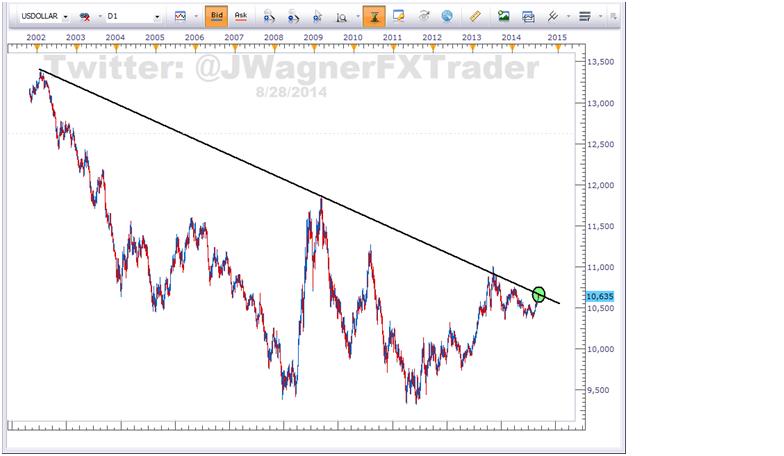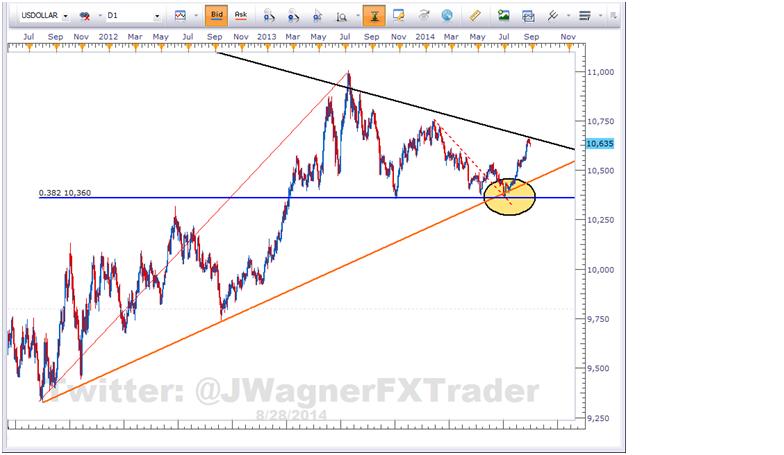The Greenback has been strengthening of late with the Fed’s bond buying policy set to end this October. Additionally, there is speculation that the Fed will be raising rates possibly in the first quarter or middle of 2015.
[Editor’s note: This article is the fourth installment in an exclusive series by DailyFX on getting started in forex. Read the previous articles here. ]
Though the Fed would not be the first central bank to boost interest rates since the depths of the Great Recession, the Fed’s move towards higher rates could affect worldwide capital flows. As a result, we could see additional strengthening of the US Dollar (Ticker: USDollar). Today, I would like to share with you the bigger technical picture that also supports a longer term up trend.
Since the Fed has injected massive amounts of liquidity into the market, there has been a debate on how it will get mopped up. The Fed’s likely policy tool for affecting rates may be changes in interest paid on reserves. Therefore, listen carefully for those words “interest on reserves” as symptoms of rate increases coming.
As the Fed is winding down the bond buying, the technical study for the USDOLLAR is quite interesting. Taking a step back and looking at the past 12 years of price action, the Buck appears technically poised to strengthen as well.

Above, we can see prices are well off their 2002 highs of 13,391. Prices are testing this 12 year trend line for the 4th time. The last time we saw a test of this resistance trend line was July 2013 with prices temporarily breaking above for a period of 3 days, then repelling lower.
Since then, prices have retraced only 38.2% of the previous up trend. So we have a temporary break higher and a shallow retracement which are, in my opinion, bullish indications of strength below the surface.
As we currently retest this 12 year trend line, prices may need to respect it one more time. Therefore, over the next few days, don’t be surprised to see a reaction lower.
However, the reaction lower and a dip in price will offer up an opportunity to position to the long side. An area to buy a dip would be 10,375-10,500.

The risk on this opportunity is clear. The lows experienced on July 1, 2014 at 10,363 came at a multitude of price support and is very strong. That means so long as we are above 10,363, we can keep our bullish bias.
If you wanted to be more conservative, you could use the upward sloping trend line from August 2011 as a line in the sand. This line currently crosses near 10,450.
If this bullish scenario plays out, upside targets include 11,000 and possibly 11,800.
Though this index weighs the Dollar against a basket of currencies, pairs to keep an eye on during a USDOLLAR run would be European markets including European emerging markets (EUR/USD, GBP/USD, USD/HUF, USD/SEK, USD/NOK have already been in nice trends). Also, keep an eye on the USD/PLN and the USD/RUB as geopolitical concerns are worked through.
I particularly like selling low yielding emerging market currencies like the HUF. If the Fed starts to hike rates, then low yielding emerging currencies will need to hike rates as well to keep their capital flows from repatriating back to the US. Those rate hikes would pressure their local economy in the face of regional deflationary cycles. If that scenario plays out, the USD/HUF may continue to rise.




